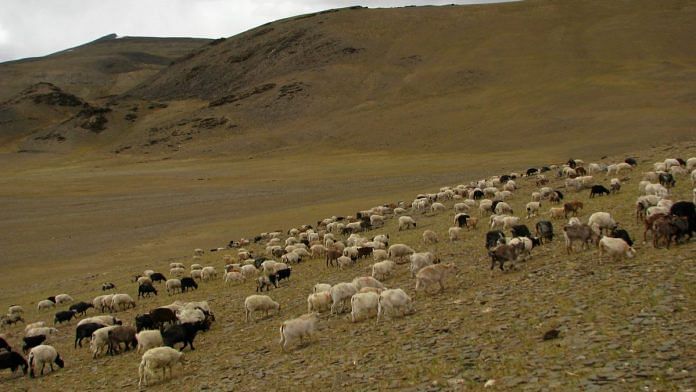August–September 1965 had turned out to be a season of disquiet marked by armies challenging boundaries, politicians trying to instigate dissidents and infiltrators breaching borders.
It was also a season of heightened diplomatic sensitivities and brittle India–China bilateral relations as can be seen by an incident that took place on 27 August, while India was fighting off Pakistani infiltrators in Kashmir. China had made a perplexing allegation that 800 sheep and 59 yaks that had crossed over into India along with their herdsmen had actually been stolen by Indian troops from the Tibetan herdsmen close to the Sikkim border. No one would have given the incident a ghost of a chance of pushing an already delicate relationship to the edge.
Such border crossings were not unusual. Earlier that year, on 29 May, two Tibetan women named Damque and Jitzongm disappeared from a place called Khampa Dzong in Tibet close to the Sikkim border. Sensing an opportunity to escape from China-occupied Tibet, the women had in fact crossed the border and reached Sikkim. Unsure and terrified, they went to the Indian police and complained about the miserable living conditions in Tibet and sought asylum in India. The Chinese, however, had a different version of the story and accused Indians of abducting the women.
Also read: Battle of Walong — how India fought its only counter-attack in 1962 India-China war
The allegation about the stolen animals evoked considerable mirth in India. China demanded the animals be returned along with the four ‘missing’ shepherds. India denied knowledge about the livestock or the men. The Ministry of External Affairs issued a statement that Indian troops had not kidnapped any Tibetans nor seized any livestock. The statement read: ‘If the Tibetans with sheep and yaks had indeed crossed over, they were free to return if they desired to do so.’ China continued to threaten India with a repeat of 1962 if the livestock weren’t returned. Beijing threatened India with war at every small opportunity. A lighthearted response was perhaps the only possible answer to the ludicrous allegation and war threat.
On 24 September, a forty-two-year-old Indian politician from the opposition decided to take matters into his own self-assured hands. He gathered a band of protestors and drove to the Chinese embassy in Delhi. Atal Bihari Vajpayee, the young politician known for his wit and sharp mind, was at the forefront of a flock of eight hundred sheep. The protestors stood before the Chinese embassy, flashing placards with the slogan: ‘Eat me but save the world!’
Annoyed at the sight of the sea of white sheep, the embassy staffers complained that the protesters were ‘a mob of Indian hooligans whose mischievous agitation was supported by the Indian government’. The Chinese ministry of foreign affairs (MFA) issued an irate note to the Indian embassy in Peking, complaining that the Indians were making a din that ‘China wants to start a world war over some sheep and a few yaks’. The note reiterated: ‘You must return every single one of the border inhabitants and livestock you kidnapped and seized from Chinese territory across the China–Sikkim border.’
The note continued: ‘The Indian Government will definitely not succeed in its attempt, by staging this ugly anti-Chinese farce, to cover up its crimes of aggression against China and the wretched picture of its troops fleeing in panic.’ The Chinese signed off on a condescending note: ‘the Indian troops who had intruded into the Chinese side of the China–Sikkim boundary could not but flee helter skelter under the surveillance of Chinese troops.’
Also read: When a spy story from India-US mission during the Cold War spooked an IAF pilot
The quirky humour behind Vajpayee’s brilliant protest was lost in the inane exchanges of the two governments. India objected to China’s comments on the protest and alleged that Peking was interfering in India’s internal affairs, even taking a swipe at the lack of political freedom in China by saying that Indians enjoyed the right to express themselves.
The acrimonious exchange wasn’t about to end as India referred to Tibet in one of its notes, suddenly appearing both unusually blunt and brave: ‘The Chinese Government appears to have been embarrassed … that there are not four but thousands of Tibetans who have left their homeland and taken refuge in India. But that is a fact, though not a creditable one for the Chinese regime in Tibet. The Chinese note has stated that these … Tibetan refugees are a debt which India owes to China. On the contrary, it is a debt which China owes to the people of Tibet for making it impossible for them to live in freedom and dignity in their own motherland.’ The Indians didn’t hold back from calling the Chinese occupation of Tibet an invasion, and even brought up the Dalai Lama, a very sore topic for the Chinese.
Four decades later, Vajpayee became India’s prime minister. The young protestor of 1965 then visited China in 2003 and succeed in breaking the long thaw in relations and reopen the trade route from Sikkim via the Nathu La pass.
Given the rising acrimony of the exchanges it was no surprise when PLA troops began to quietly make their way to a border mountain in Sikkim, its sight on another sleepy, beautiful pass on the Sikkim–Tibet border. The gentle pass was so even, it was called ‘the lovely level pass’ in the local dialect or simply, Jelep La.
Also read: India’s misplaced priorities, shoddy planning & complacency led to 1962 war
Jelep La was historically used by traders, soldiers, refugees and travellers alike to move between Sikkim and Tibet. Trade flourished as caravans from Kalimpong, West Bengal, regularly made their way to the markets in Lhasa, Tibet. But when the big war broke out in 1962, Jelep La was shut down. During the war, a Chinese attack loomed large and Indian troops, stationed at the pass, were ready. The fighting happened elsewhere while the pass, like Nathu La, continued to be held by Indian troops.
After 1962, Jelep La was almost forgotten except by Indian forward detachments that sat guarding it. It began to be referred to as the Lonely Pass. In the fall of 1965, with the arrival of Chinese troops along the Tibet–Sikkim border, the Lonely Pass transformed into a hub of activity once again.
 This excerpt from Watershed 1967: India’s Forgotten Victory over China by Probal Das Gupta has been published with permission from Juggernaut.
This excerpt from Watershed 1967: India’s Forgotten Victory over China by Probal Das Gupta has been published with permission from Juggernaut.



